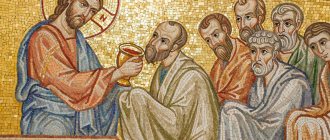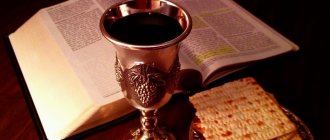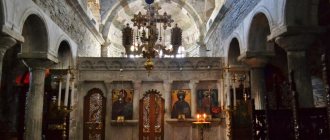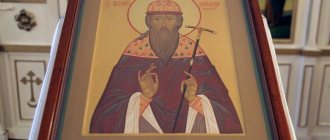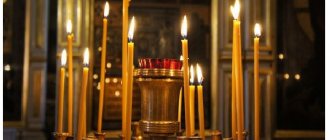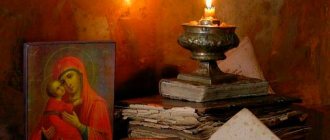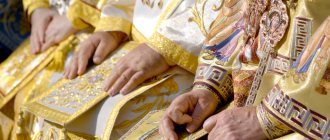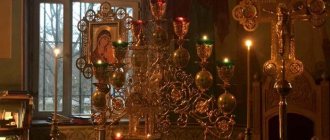How to pray in church
Orthodox Christians have accepted from the Holy Fathers and practice the following customs all over the world: 1. Entering the temple and making the sign of the cross, they make three small bows, saying: “He who created me, Lord, have mercy.” “God, be merciful to me, a sinner.” “I have sinned beyond number, Lord, forgive me.” 2. Then, bowing to the right and left, they stand still and listen to the psalms and prayers read in the church, but do not say other prayers to themselves, their own, and do not read them from books separately from church singing, for such are condemned by St. the Apostle Paul, as those withdrawing from the church meeting (Heb. 10:25). 3. Small and great bows should be done not according to one’s own will, but according to the institution of the saint. apostles and saints father. Namely: when reading the Trisagion (“Holy God”), “Come, let us worship” and the threefold “Alleluia”, make the sign of the cross three times, making small bows; the same thing when reading “Vouched, O Lord,” as well as at the beginning of the great doxology (“Glory to God in the highest”) and after the words of the priest: “Glory to Thee, Christ God, our hope.” After each exclamation of the priest, as well as when the reader reads “The Most Honorable Cherub,” make the sign of the cross and make a small bow. On weekdays, bow to the ground during the liturgy: a) at the beginning of the singing “Worthy and Righteous”; b) when the prayer “We sing to You” ends; c) at the end of the prayer “It is worthy to eat” or Zadostoynik; d) at the beginning of the prayer “Our Father”; e) when wearing St. Gifts for communion e) and with the words “Always, now and ever.” At Matins or the All-Night Vigil, when it is proclaimed: “Let us exalt the Virgin Mary and Mother of Light in song.” On Sundays well as from St. Day. Easter until the evening of St. Trinity, as well as from the day of the Nativity of Christ to the day of Baptism, also on the day of the Transfiguration and Exaltation, the holy apostles completely forbade kneeling and to , as evidenced by St. Basil the Great in his letter to Blessed Amphilochius. The same was approved by the Ecumenical Councils I and VI; for Sundays and other feasts of the Lord contain the remembrance of our reconciliation with God, according to the word of the Apostle: “Be a servant, but a son” (Gal. 4:7); It is not appropriate for sons to perform slavish worship. 4. It is not common for Orthodox Christians to kneel with their heads raised, but at the words of the priest: “Pack and pack, bend the knee,” and so on. to prostrate oneself on the ground; The custom of kneeling at one’s own will, folding one’s hands and beating one’s chest was adopted from Western heretics, but is not allowed in the Orthodox Church. Orthodox Christians, according to the Church Charter, bow to the ground at the appointed time, prostrate themselves and stand on their feet again. 5. When in church they signify the people with a cross or the Gospel, an image or a Chalice, then everyone is baptized, bowing their heads, and when they signify with candles or bless with their hands, or burn incense to those present, then Orthodox Christians should not be baptized, but only bow their heads; Only on Bright Week of Easter, when the priest censes with the Cross in his hand, does everyone cross themselves and say: “Truly he is risen.” Thus, there should be a distinction between worship before a shrine and before people, although in a holy order. 6. When accepting the blessing of a priest or bishop, Christians kiss his right hand, but do not cross themselves before doing so. One should not kiss the left hand of clergy, for this is characteristic only of Jews, but the right hand, through which the blessing is transmitted. 7. The sign of the cross, according to the teachings of the holy fathers, should be done like this: folding your right hand into three fingers, place it on your forehead, on your belly, on your right shoulder and on your left, and then, placing the cross on yourself, bend over; about those who signify themselves with all fives or bow before finishing the cross, or wave their hand in the air or across their chest, it is said in Chrysostom: “The demons rejoice at that frantic waving.” On the contrary, the sign of the cross, performed earnestly with faith and reverence, frightens demons, calms sinful passions and attracts Divine grace.
To make it easier and more undistracted to attend the liturgy, try to pray like this: while reading the hours, remember the dead and the living. This commemoration will ascend with the remembrance of the priest to heaven and will give great joy to the souls of those commemorated. It doesn’t matter here whether you commemorate it at the altar near the altar, at the door to the altar or in the church - the Lord will hear it everywhere. When the liturgy begins with the words: “Blessed is the Kingdom...”, pray that the Lord will grant you the Kingdom of Heaven. During the first peaceful litany, pray that the Lord will give you His peace for today. Nothing has such a beneficial effect on the soul as a peaceful state, and it is especially annoying to the enemy of salvation. He wants in every possible way to disrupt it, to take a person out of a peaceful dispensation, to introduce quarrels, irritation, anger, annoyance, and grumbling. Therefore, when praying for peace to be sent down to your soul, feel like you are on a plank among the raging waves, feel your helplessness and ask for help from the Lord. When the antiphons are sung, the clergyman reads prayers for the preservation of the Church, and you pray for the same, and also that the Lord will deliver the city in which you live, it is unbelief, heresy, division. In front of the small entrance, the priest reads a prayer: “Create at our entrance the holy Angels of existence, co-serving with us.” At this time, a countless number of Angels fill the Church. And you pray to your Guardian Angel so that he will stand next to you and pray with you: Holy Guardian Angel, have mercy on me and visit me at this hour and pray with me and for me. During the reading of the Apostolic Epistle and the Gospel, an endless number of candles are lit by the Angels, invisible to us. The clergyman reads the prayer: Shine in our hearts, O Master who loves mankind, Your imperishable light of God’s understanding, and open our mental eyes, understanding in Your gospel preachings. At this time, pray that the Lord will send His Divine light to you too, and that it will shine in your heart. The next litany is a special one, when for each petition the choir sings “Lord have mercy...” three times. This litany represents the entire earthly life of the Lord, when crowds of people followed Him shouting: “Have mercy on us!” Bring everyone before your eyes: the Canaanite woman, the blind man, and the leper. Having fallen to the Lord with all your soul, feel yourself a leper, and possessed, and blind. Mentally cling to the edges of the Lord's robe and beg for mercy; it is good to prostrate yourself before the icon. The exclamation after the litany gives hope that the Lord will hear your cry in His great mercy: for You are a merciful and Lover of mankind, and we send glory to You, the Father and the Son and the Holy Spirit...
During the litany for the catechumens, pray for the unbelievers. Maybe you have relatives or friends who are not believers. Pray that the Lord will have mercy on them and enlighten their souls with the light of faith. Then thank the Lord that it is only by His providence that you yourself are among the faithful. The Cherubic Song is the prayer of the Lord in the Garden of Gethsemane. Here, bring before you the entire Gethsemane feat of the Lord, His prayer to the point of bloody sweat, His suffering for the sins of people. Remember that you too passed before the eyes of the Lord with all your falls and sins. Feel that the Lord suffered for you that night. Be especially aware of your complete unworthiness, how you repay the Lord for what He has done to you, and ask Him for mercy. Just as the Lord was obedient to the will of His Father, so you too surrender yourself to the will of the Lord and decide to patiently bear the cross sent to you. During the great entrance, depicting the crucifixion of the Lord, ask Him to remember you in the Kingdom of Heaven. At the cry of “Peace to all!”, depicting the Lord’s entry into hell to save those who have died and were there before His coming, pray like this: Enter, O Lord, into the hell of my soul and save me. When you hear the cry “Let us love one another, that we may be of one mind,” pray that the Lord will put bright love into you and allow you to love everyone, especially those whom you do not love or offend, and those who offend you and do not love you. At the cry “Let us become kind, let us become fearful...” - pray that the Lord will put His fear in you, so that you will always remember the presence of the Lord. When shouting “We thank the Lord...”, give special thanks. At this time, the clergyman reads a prayer that remembers all the good deeds of the Lord to people, thanks for them and for the liturgy being performed. And everyone is obliged to give thanks for this, and in particular for what the Lord has given to him personally, what mercies he has showered upon him. During “We Sing to You,” we must remember our especially serious sins and ask the Lord for forgiveness for them. If you sit through the liturgy like this with all your attention and diligence, you will certainly receive benefits.
Saint Seraphim of Dmitrov
How is the liturgy conducted in the Orthodox Church?
Estimated reading time: 5 min.
Liturgy is the main Christian service, during which the main sacrament takes place - the Eucharist: under the guise of bread and wine, believers eat the Body and Blood of Christ. Before the start of the service, parishioners write notes about the living and those who have already passed into another world. This custom is well known to unchurched people, but its meaning often remains “behind the scenes.” The point is that during the service, believers are given the opportunity to remember their relatives and friends several times, and notes are one of these opportunities.
The service begins with the reading of the Hours - a short service that prayerfully illuminates a certain time of day (from six o'clock in the morning to six o'clock in the evening). While the reader and parishioners are praying, the priest performs proskomedia. This is the first part of the Liturgy, consisting of three: Proskomedia, Liturgy of the Catechumens and Liturgy of the Faithful.
Proskomedia is the preparatory part before the start of the Liturgy. Bread and Wine are prepared on it, which then, through the prayers of the priest, are transformed into the Body and Blood of Christ. “And he took the bread and gave thanks, and broke it and gave it to them, saying, “This is My body, which is given for you; Do this in remembrance of Me (Luke 22:19). This is how the Sacrament of the Eucharist was established, where Christians, under the guise of bread and wine, partake of the Body and Blood of the Savior and become one with Him. Participation in this sacrament is a necessary condition for every Christian to remain in the Church. In addition, prayers are read for the living and the dead (exactly those mentioned in the notes). Particles are taken out of the prosphora (bread used for the Sacrament), which symbolize members of the Church. Prosphora is baked from wheat leavened bread and must be made up of two parts (an image of the two natures in Jesus Christ - human and divine). It symbolizes the bread that Christ divided among his disciples at the Last Supper. Wine (red, without any additives) is mixed with water as a sign of remembrance that blood and water poured out from the Savior’s wound on the Cross. Five prosphoras are used as a sign of memory of the miracle of being fed with five loaves, which Christ performed. The first prosphora is Lamb. After reading certain prayers in front of the Closed Gate and putting on sacred clothes, the priest draws an image of the cross on it with a copy, cuts out the middle (Lamb) and places it on the paten (round dish). The priest then cuts the Lamb on the underside and pierces it on the right side with a spear. Afterwards the wine is mixed with water. The second prosphora is called the Mother of God, because a particle is taken out of it in honor of the Most Holy Theotokos. The third is in honor of John the Baptist, the prophets, apostles, martyrs and everyone who pleased God. Particles for the living and the dead are taken out from the fourth and fifth prosphoras. The removed particles are laid out on the paten next to the Lamb. The priest places a star on the paten, covers it and the bowl with covers, and then all together with a large cover (air). Shortly before the end of the reading of the Hours, the priest comes out of the altar with a censer in order to burn incense in the temple. Ceremony is an integral part of the divine service and expresses, firstly, Divine love, poured out on the entire human race, and secondly, the grace of the Holy Spirit, which mysteriously sanctifies and delights everyone, and also helps those praying to offer their prayers to the Throne of the Most High.
The hours are read, the Liturgy of the Catechumens begins. It received its name because it could be attended not only by members of the Church, but also by those who were just preparing to receive Baptism. With the blessing of the priest, the deacon from the pulpit announces the beginning of the service. The priest glorifies the Holy Trinity with his voice, the choir alternately sings psalms with the left and right choir (antiphonally), the Great Litany is pronounced (forgiveness from God of mercy and blessings). At the end of the singing, the priest, together with the deacon, who has the altar Gospel in his hands, goes out to the pulpit. With symbolic actions, the deacon reminds the believers that they will now hear the holy Gospel and therefore must stand upright (the exclamation “Wisdom, forgive (upright)” is reminiscent of this). This is how the Small Entrance is performed, marking the entrance of Jesus Christ to preach - every ritual action in the Church is deeply symbolic and carries a deep meaning. After the reading of the Apostle and the Gospel, a special litany is performed, and this is the second opportunity when we can pray for those who are dear to us. Next, the litany of the catechumens is raised, and in ancient times, after this, all unbaptized were removed from churches. Now this tradition is not observed.
The Liturgy of the Faithful begins. The gifts are transferred from the altar to the throne. The priest secretly prays that the Lord will make him worthy to perform this great Sacrament. At this time, the choir sings a song called the Cherubic Song. Then the priest, carrying the Holy Chalice in front of him, together with the deacon goes to the pulpit and says a prayer for the Patriarch, bishops and all Orthodox Christians. After which they make the Great Entrance into the altar.
The call to love the Holy Trinity is heard, and the believers sing the “Creed,” which reminds us of what the hope and hope of the Church is. Then the “Holy Ascension” begins. Believers bow down and thank the Lord for all His blessings and His mercy. The priest, in secret prayer, asks the Lord to send His Holy Spirit on the people in the church and on the Offered Gifts. Prayers are also offered so that believers will be strengthened in goodness, so that God will allow them to turn to Himself with their needs. Out loud, the priest bless those present, and the litany of petition begins. The Lord's Prayer is sung by all those present.
The deacon girds himself with an orarion, exclaims “Let us behold,” and the curtain of the Royal Doors draws, thereby recalling the stone that was rolled to the Holy Sepulcher. The priest, raising the Holy Lamb, proclaims “Holy to holy.” Believers answer: “There is one holy, one Lord, Jesus Christ, to the glory of God the Father,” thereby realizing their unworthiness.
The clergy receive communion first. The priest breaks the Lamb into four parts: the part with the inscription “IC” is lowered into the bowl, then hot water (heat) is poured into it. The other part with the inscription “ХС” is for the communion of clergy, the part with the inscriptions “NI” and “KA” is for the laity.
While the clergy are receiving communion, the so-called Communion Canon is sung. Finally the Royal Doors open. The priest comes out with the Chalice in his hands, says a special prayer, the communicants approach, folding their arms in a cross shape on their chest and saying their name. After Communion, believers are given zapivka (wine mixed with hot water). This is necessary so that no particles of the Holy Gifts remain in the mouth. The priest brings the cup to the altar and dips particles from the brought prosphoras into it with a prayer that the Lord will wash away the sins of all who were commemorated at the Liturgy. This is the last time we can prayerfully remember our relatives and brothers and sisters in faith. The Dismissal takes place, the believers come up and kiss the cross in the hands of the priest. It is advisable to spend the rest of the day reverently, keeping the grace received and remembering God.
